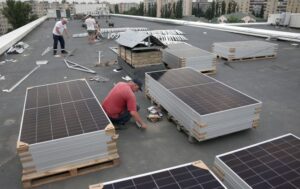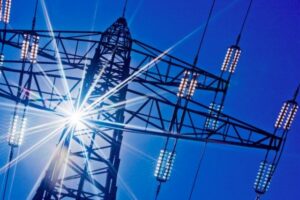
The development strategy of Kormotech, a leading Ukrainian pet food manufacturer, includes the use of green energy, and the company aims to provide up to 15% of its own generation by 2027, Kormotech’s Chief Operating Officer Igor Paranyak said in an interview with Interfax-Ukraine.
“Our strategy includes steps towards the use of green energy. At the moment, we have already implemented a project to install a 630 kW solar station at the first factory in Lithuania. At the new factory (Kėdainiai, Lithuania), we also plan to install solar stations on the roof of the factory; given the rather large area, almost 17 thousand square meters, it will be a large SPP. It is not part of this (EBRD loan – IF-U) project, we will implement it separately, but we plan to have 15% of our own electricity generation by 2027,” Paraniak said.
As reported, Kormotech has started construction of a new wet animal feed plant in Lithuania, in which it is investing EUR 60 million, of which EUR 40 million was provided by the EBRD. The planned capacity of the new plant is 40 thousand tons, and 200 jobs will be created. The first phase of the plant is scheduled to be launched in the second quarter of 2026, and all four phases by the end of 2028.
Kormotech is a global family-owned company with Ukrainian roots that has been producing high-quality food for cats and dogs under the Optimeal, Delickcious, Club 4 Paws, Woof, Meow! My Love. The company has production facilities in Ukraine and the EU. The product range includes more than 650 items. Kormotech is a leader in Ukraine, one of the TOP-50 global pet food producers and TOP-20 most dynamic pet food brands. Kormotech sells products of its own brands and its partners’ own brands to 46 countries.
The Kormotech Group of companies ended 2024 with $162.7 million in turnover, which is 6.5% more than in 2023. In total, last year the group of companies sold 83 thousand tons of dry and wet diets for cats and dogs, which is almost 7.5% more than in 2023.

In June-October 2024, Ukrainian banks financed 310 MW of generation facilities in 21 regions of the country, the Ministry of Energy reported, citing the results of a survey of banks conducted by the National Bank of Ukraine.
“The total amount of loans actually issued for the energy needs of legal entities is UAH 3.4 billion,” the statement said.
In addition, banks are reportedly lending to households. In particular, in October, 1 thousand loans totaling UAH 176 million were granted to individuals. The total gross portfolio of loans related to the energy needs of individuals increased to UAH 366 million.
According to the NBU, from June to October 2024, banks received a total of 2,927 thousand applications from businesses for loans to install energy equipment to strengthen energy independence, totaling UAH 66.2 billion. Of these, applications for UAH 11.7 billion were approved.

PJSC Ukrnafta will raise UAH 4 billion in loans from Ukrgasbank to drill new wells and build and commission gas piston units, the company’s press service said on Friday.
“The borrowed funds will be used to finance drilling and production stimulation programs and the construction of modern gas piston stations,” said Sergiy Koretsky, Ukrnafta’s director.
As reported, Ukrnafta has announced 16 tenders for the purchase of gas reciprocating power plants with a total capacity of 63.59 MW-76.4 MW. These are plants with a capacity of 1-1.3 MW (two sets), 1.6-2.1 MW (one), 1.95-2.5 MW (two), 2.4-3.1 MW (three), 2.94-3.7 MW (one), 3.9-4.5 MW (three), 4.4-5.2 MW (one), 5.85-6.8 MW (one), 12-14.1 MW (two). The start of the auctions has been extended by two weeks to September 9-10, 2024.
“In 2023, Ukrnafta increased oil and condensate production by 3% (by 39.9 thousand tons) compared to 2022, to 1.4 million tons. Last year, Ukrnafta produced 1.097 bcm of natural and associated petroleum gas, which is 5.8% (60.4 mcm) more than in 2022.
“Ukrnafta is the largest oil producer in Ukraine and the operator of the national network of filling stations. In March 2024, the company took over management of Glusco’s assets and operates 545 filling stations – 460 owned and 85 managed.
The company is implementing a comprehensive program to restore operations and update the format of its filling stations. Since February 2023, Ukrnafta has been issuing its own fuel coupons and NAFTA cards, which are sold to legal entities and individuals through Ukrnafta-Postach LLC.
Ukrnafta’s largest shareholder is Naftogaz of Ukraine with a 50%+1 share. In November 2022, the Supreme Commander-in-Chief’s Office of the Armed Forces of Ukraine decided to transfer to the state a share of corporate rights of the company, which belonged to private owners and is currently managed by the Ministry of Defense.

As part of its preparations for the next heating season, the Ukrainian government will focus on the speedy construction of small-scale generation facilities for Kharkiv and other cities, with a further transition to the construction of large gas turbine plants in the medium term.
This was announced by Oleksandr Kubrakov, Vice Prime Minister for Recovery of Ukraine, on the air of the national telethon “United News” on Friday evening.
“We will try to build urgent low-capacity facilities for cities such as Kharkiv before the next heating season together with our partners. There are cogeneration units already provided by some governments. This may be the main solution for Kharkiv for this season,” he said.
According to the Vice Prime Minister, an action plan is currently being drawn up at the government level and in close consultation with local authorities, which should be implemented by the beginning of winter.
“In the medium term, large gas turbines with high efficiency are our future. We need several gigawatts of such capacities across the country,” Kubrakov said.
As he explained, gas turbine construction projects are quite attractive to investors due to, among other things, their high efficiency and low cost of electricity production.
“I hope that the export credit agencies of those countries that produce such equipment – the United States, Germany, and Japan – will be able to provide us with financing for their equipment, and we will be able to implement this plan,” the Deputy Prime Minister stated.
As reported, more than 85% of Ukraine’s thermal generation capacity and about 50% of its hydroelectric generation capacity have been destroyed as a result of enemy massive attacks.
According to former Energy Minister Olha Buslavets, in May of this year, the electricity deficit in Ukraine may reach about 3 GW.

Due to Russia’s strikes on the power grid, Nova Group has decided to set up Nova Energy to develop regular power generation, ensuring the autonomy of the company’s facilities, said Volodymyr Popereshnyuk, co-owner of Nova.
“When the Russians have recently started to hit the power generation, we realized that we needed to strengthen the autonomy of energy supply. We created Nova Energy, which will generate energy on a regular basis, including electricity generated by the sun and gas,” Popereshnyuk wrote on Facebook on Thursday.
He expressed hope that other companies would do the same.
“If regulations and bans do not interfere, entrepreneurs will very quickly create the capacities necessary for the economy. Because there are no problems that entrepreneurs are not able to solve,” Popereshnyuk wrote.
He recalled that at the beginning of the full-scale war, when Russia attacked Ukrainian refineries and oil depots, which led to an acute fuel shortage on the fuel market, Nova began purchasing fuel trucks, tanks, tanks, and fueling complexes to strengthen its fuel security and autonomy.
“Now we provide 60% of the fuel we need with our own resources,” said Popereshnyuk.
During the first wave of attacks on energy facilities in Ukraine in the fall and winter of 2022, Nova provided generators and batteries to its network of branches and sorting centers.
Earlier, Volodymyr Kudrytskyi, Chairman of the Board of NPC Ukrenergo, said that it would be advisable for industrial electricity consumers to consider providing themselves with their own generation to strengthen their energy resilience in the face of Russian attacks on the power system.

Electricity generation in the Integrated Power System of Ukraine in January-April 2021 increased by 5.8% (by 2.978 billion kWh), year-over-year, to 54.616 billion kWh, according to the Energy Ministry.
According to the calculations of Interfax-Ukraine, nuclear power plants (NPPs) have increased electricity generation by 0.4% in four months, to 29.7 billion kWh. In particular, electricity generation at Zaporizhia NPP amounted to 13.569 billion kWh (more by 22.5% compared to January-April 2020), Yuzhnoukrainsk NPP some 5.810 billion kWh (less by 24.2%), Rivne NPP some 5.32 billion kWh (less by 26.6%), Khmelnytsky NPP some 4.597 billion kWh (more by 39.5%).
Thermal power plants (TPPs), as well as combined heat and power plants (CHPPs) and cogeneration plants increased their output by 9.1%, to 18.39 billion kWh. In particular, TPPs increased generation by 15.9%, to 13.29 billion kWh, while CHPPs and cogeneration plants cut it by 5.2%, to 5.11 billion kWh.
Hydro power plants and pumped storage power plants increased generation by 60.9%, to 3.676 billion kWh, while block stations cut it by 6.5%, to 587 million kWh.
Electricity generation by alternative sources (wind farms, solar power plants, biomass) decreased by 0.1%, to 3.306 billion kWh.
The share of NPPs in the structure of electricity generation was 53.1% (55.9% in January-April 2020), TPPs, CHPPs and cogeneration plants some 33% (32%), hydro power plants and pumped storage power plants some 6.7% (4.4%), block stations some 1.1% (1.2%), alternative sources some 6.1% (6.4%).
In April 2021, electricity generation in Ukraine increased by 11.9% (by 1.342 billion kWh), year-over-year, to 12.607 billion kWh.
In addition, the supply of thermal energy in January-April 2021 increased by14.8% (by 1.608 million Gcal), year-over-year, to 12.450 million Gcal.